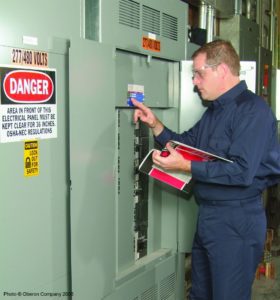This audio was created using Microsoft Azure Speech Services
Electricity – I have heard it called ‘an invisible servant’. It is one of those things in life which you can’t see but you know is there. Most of the time, Electricity is safe but under fault conditions (for example if someone slips and causes a short with a metal tool) a spark or ‘arc’ can occur. If conditions are right, high power electricity can produce a self sustaining fire-ball, which can make a force-able exit from electrical equipment. This ball of ionized gas and vaporized metal can reach temperatures of 35,000 degrees F and is perfectly capable of incinerating anything or indeed anyone in its path.

Electrical and Industrial companies, among others, are aware of the danger arc flash presents to their workers. Arc fault prevention equipment is available, and the National Fire Protection Association (NFPA) has established guidelines for protective equipment, which must be worn when workers are in the vicinity of equipment where enough electrical energy exists to cause a risk of personal injury.
NEC 2011 P 70-37 “Requirements For Electrical Installations” states that employers must provide labels which tell employees the level of protective equipment they must wear when working near a particular piece of equipment. To label a piece of equipment correctly, it is necessary to know how much energy is available at the point of connection to the buildings electrical network. To do this properly, a detailed electrical study must be performed. This study must be referred to each and every time a label is made as hundreds of possible labels exist and new equipment often comes into the plant from sub suppliers.
 Keeping track of all of the study data and making sure all the equipment is labeled properly is a challenge but one which must be met to ensure worker safety and regulatory compliance. Failure to comply with these regulations isn’t an option. Today, web based tools can be developed to help employers print new labels using the right study data to make sure that the protective equipment specified on that label is correct. Companies supplying new equipment to the facility can also access these web tools and request their own labels so everything is labeled correctly when it arrives at the target facility. This is a great example of modern technology at work to make sure workers are protected and employer liability is minimized.
Keeping track of all of the study data and making sure all the equipment is labeled properly is a challenge but one which must be met to ensure worker safety and regulatory compliance. Failure to comply with these regulations isn’t an option. Today, web based tools can be developed to help employers print new labels using the right study data to make sure that the protective equipment specified on that label is correct. Companies supplying new equipment to the facility can also access these web tools and request their own labels so everything is labeled correctly when it arrives at the target facility. This is a great example of modern technology at work to make sure workers are protected and employer liability is minimized.
I would be eager to learn how you keep track of Arc Flash labeling in your facility??




Conversation
Mark McCracken
11 years ago
You have miss quoted NFPA 70 2011 P70-37. The labeling you are refering to is in NFPA 70e which though not a legal document is being enforced by OSHA & MSHA. Local building inspectors enforce NFPA 70 because it is adopted by each state as being the law & is to be enforced. NFPA 70e is not law & is not enforcable as such. The current NFPA 70e is a BAD document. I am open to debate if you want the truth about NFPA 70e.
John Boville
11 years ago
Hello Mark,
Many thanks for taking the time to comment!
I was paraphrasing 110.16 of the National Electric Code 2011 Edition.
‘Arc Flash Hazard Warning. Electrical equipment, such as switchboards, panelboards, industrial control panels, meter socket enclosures, and motor control centers, that are in other than dwelling units, and are likely to require examination, adjustment, servicing or maintenance while energized shall be marked to warn qualified persons of potential arc flash hazards. The marking shall be located so as to be clearly visible to qualified persons before examination, adjustment, servicing or maintenance of the equipment.
Informational Note No. 1: NFPA70E-2009. Standard For Electrical Safety in the Work Place, provides assistance in determining severity of potential exposure, planning safe work practices, and selecting personal protective equipment.’
So you are correct. NEC2011 defines the need to label the equipment to warn of the potential hazard but cross references NFPA70E-2009 when it comes to the severity of potential exposure and selecting protective equipment.
Thanks for the clarification.